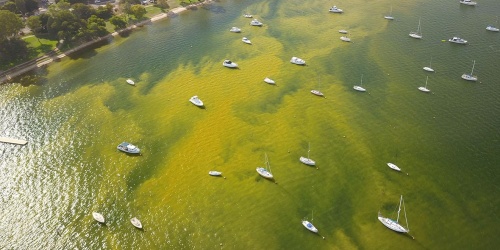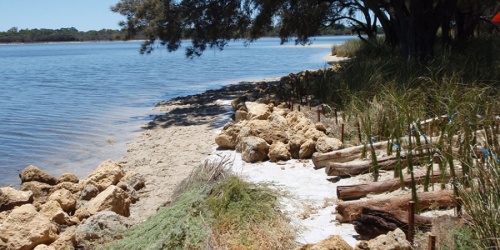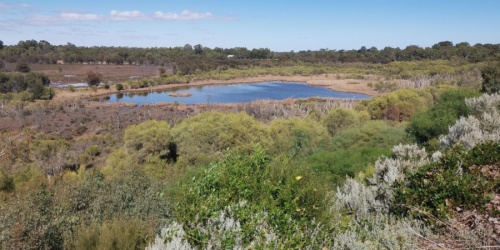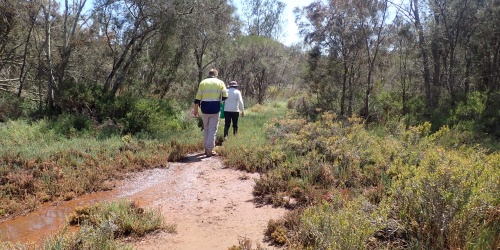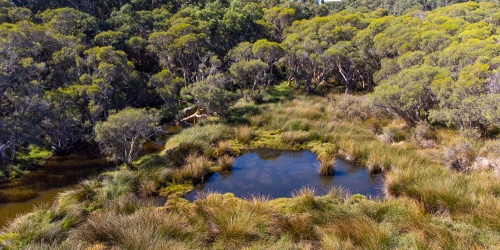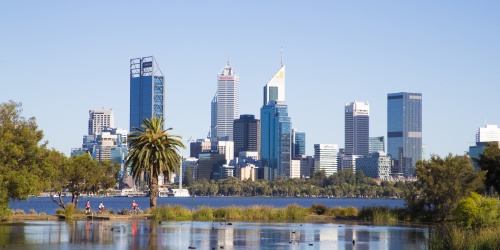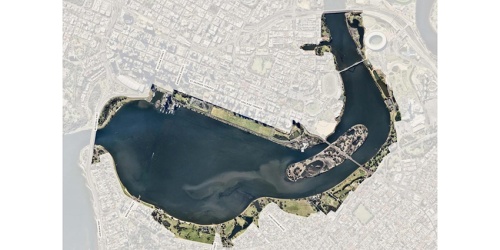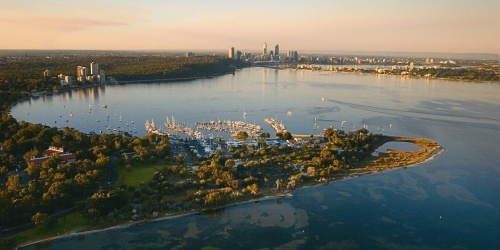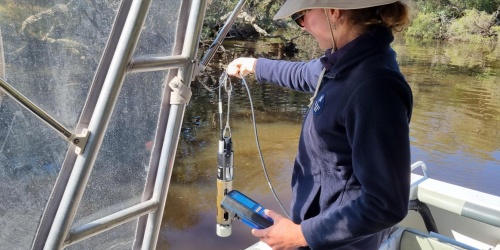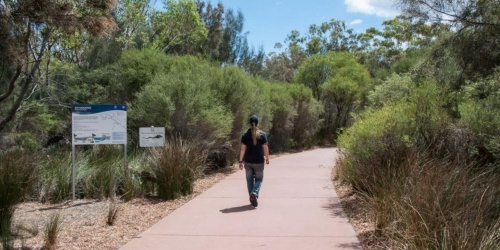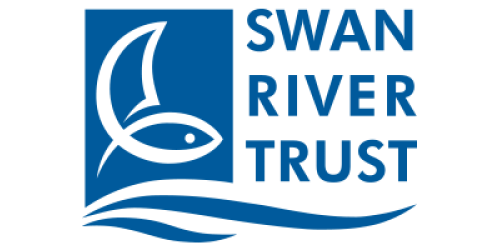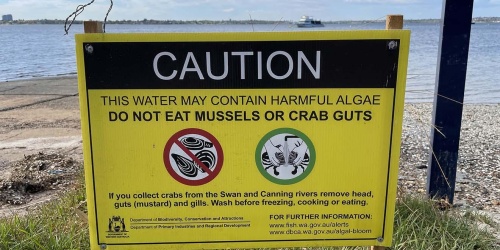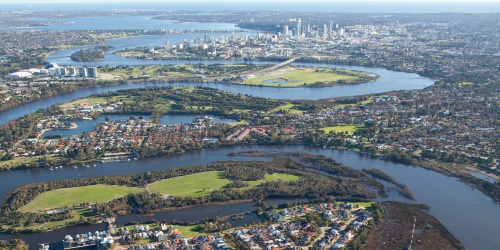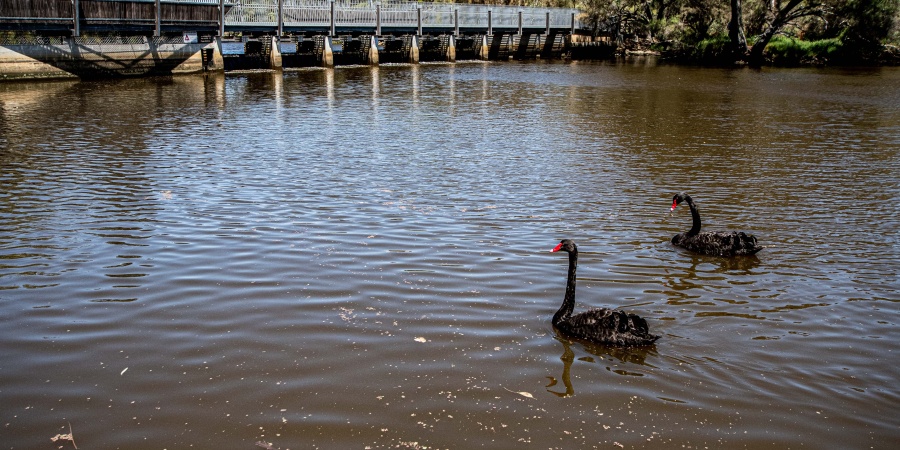
Kent St River swans
DBCA is committed to ensuring a sustainable healthy ecosystem. DBCA works closely with other State Government agencies, local government authorities, community groups and research institutions to manage the health of the ecosystem. DBCA's Parks and Wildlife Service is responsible for the waterways and has joint responsibility for the Riverpark shoreline in conjunction with the local or State government land managers under which the adjacent land is vested.
Management of the river system is guided by the Swan Canning River Protection Strategy, which provides a master plan to guide investment, keep the rivers healthy and ensure they are accessible for the community to enjoy. The Parks and Wildlife service has a key role in implementing the strategy and will help coordinate the relevant management actions and reporting on the strategy from 12 partner organisations. Find out more about the Swan Canning River Protection Strategy in the download below and on the Swan River Trust website.
Water quality and ecological health
The Swan Canning Riverpark is a highly productive system that is showing similar signs of environmental stress to other urban waterways around the world.
Community consultation has confirmed that people connected to the Riverpark consider water quality of prime importance to the values of the system as a whole. This is because good water quality is the cornerstone of enjoyment of so many activities and values associated with the river system.
Changes in water quality can affect social values and ecological health, a term which relates to the productivity of the waterway, its biological diversity and resilience to the negative impacts of a variety of pressures.
A range of factors have the potential to impact on the water quality and ultimately the ecological health and wider community values of the river system.
- Excess nutrients (phosphorus and nitrogen) and organic loading enter the Swan Canning river system through groundwater, drainage and catchment runoff. These promote algal blooms and low oxygen conditions, which in turn places stress on fish and other aquatic life and can contribute to fish kills.
- Contaminants such as heavy metals, pesticides and herbicides enter the waterway through the drainage network. They can be directly toxic to organisms, affect life cycles and enter the food chain. Some of these ‘non-nutrient contaminants’ can also result from disturbing acid sulphate soils.
- Water borne pathogens can pose a risk to public health.
A number of plans have been developed to ensure a cohesive approach to dealing with water quality issues in the Swan and Canning rivers and the catchment.
The Swan Canning Cleanup Program (SCCP) 1999-2004 was launched by the Swan River Trust to tackle the increasing incidence of algal blooms in the Swan Canning river system.
The evaluation of the SCCP informed the development of the Healthy Rivers Action Plan (HRAP) 2008-2013, a $40 million plan to protect the environmental health and community benefit of the rivers by improving water quality through a catchment to coast approach. The HRAP was reviewed in 2014 and found to have been effective with good progress achieved on the six action areas targeted to improve water quality. Overall, 78 per cent of the targeted actions were accomplished.
The programs that implemented the HRAP will continue to deliver the Swan Canning River Protection Strategy, which focuses on managing the Riverpark through a collaborative framework approach. Find out more about the Swan Canning River Protection Strategy on the Swan River Trust website.
Water quality and ecological health - Nutrient and organic loading
Nutrient and organic loading to the Swan Canning river system is a priority issue for the waterway that has impacts on water quality, ecological health and community benefit.
Nutrients are elements or compounds including nitrogen, phosphorus and organic carbon. They enter the rivers from the catchments through drains, surface runoff and groundwater. The most common sources of nutrients entering our rivers include fertilisers, plant matter (e.g. grass clippings, leaves), detergents, sewage and animal waste.
Nutrients are essential for plant growth, including algae, but excess nutrients fuel algal blooms and can promote harmful algae.
Data from 2009 hydrological and nutrient modelling of Swan Canning sub-catchments (8.96MB) show that an estimated 26 tonnes of phosphorus and 251 tonnes of nitrogen flow into the Swan Canning river system each year. Subsequent modelling of the Avon Catchment (11.52MB) in 2015 estimated that 5 tonnes of phosphorus and 213 tonnes of nitrogen flow from the Avon each year.
Swan Canning Water Quality Improvement Plan
In 2006 the Australian Government identified the Swan Canning river system as a coastal 'hot spot' and funding was provided to coordinate a water quality improvement plan for the region. The Swan Canning Water Quality Improvement Plan (4.71MB) (SCWQIP) was released in December 2009.
Modelling undertaken as part of the SCWQIP was used to map water quality conditions in 30 sub-catchments in the Swan Canning Catchment. Based on that predictive modelling the maximum acceptable load to the Swan and Canning rivers per year is 128 tonnes of total nitrogen and 14 tonnes of total phosphorus. The SCWQIP aims to reduce the nitrogen load by 123 tonnes (49 per cent), and phosphorus load by 12 tonnes (46 per cent) annually.
The plan guides investment until the end of June 2017, identifying the most cost-effective management actions to address sources of land-based nitrogen and phosphorus and improve estuarine and coastal water quality.
The following Swan Canning Water Quality Improvement Plan publications are available in the download section below.
- Quantifying nutrient removal by riparian vegetation in Ellen Brook
- Process of nutrient removal in riparian zones in sandy soils
- An assessment of the associated environmental benefits of riparian vegetation in the Ellen Brook Catchment
Local water quality improvement plans
Parks and Wildlife have developed and invested in 10 local water quality improvement plans (WQIPs) for priority catchments, providing local councils and communities with guidance to improve water quality. The WQIPs were developed as a joint project between local government regional and sub-regional natural resource management groups, community groups, State Government agencies and the Water Corporation.
Each plan uses a five-step process to trace nutrient and pollutant pathways through catchments from the source to point of discharge. Each plan identifies existing ecological condition, water quality and pollutant loads, identifies environmental values of water bodies and water quality objectives to protect those values, and identifies and commits to a set of cost-effective management measures to achieve and maintain those values and objectives. The WQIPs have attracted substantial funding which has enabled the implementation of a number of projects including on-ground works, community education and working with local government and industry to facilitate best practice.
View the local water quality improvement plans in the download section below.
Tackling nutrients through drainage and nutrient intervention
The Drainage and Nutrient Intervention Program (DNIP) facilitates on-ground works to improve water quality in priority urban and rural drains, tributaries and catchments, influences policy and practice through innovation, project evaluation and demonstration, and guides investment and identifies the most cost-effective management actions to address sources of land-based nutrients, through initiatives such as the Swan Canning Water Quality Improvement Plan.
DNIP works include drain restoration, re-establishment of tributary vegetation, wetland creation and use of nutrient retentive materials. DNIP also trials and operates new nutrient intervention technologies, engages stakeholders and monitors and evaluates drainage restoration works.
DNIP demonstration projects include:
- Ellen Brook Wetland, Ellen Brook Catchment
- Eric Singleton Bird Sanctuary Wetland, Bayswater Brook Catchment
- Liege Street Wetland, Canning Plain Catchment
- Wharf Street Wetland and Civic Parkland, Canning Plain Catchment
- Ellen Brook, Brand Highway Nutrient Filter, Ellen Brook Catchment
- Muchea North Drain Nutrient Filter and Wetland, Ellen Brook Catchment
- Bingham Road Creek Wetland, West Bullsbrook, Ellen Brook Catchment
- Anvil Way Compensation Basin Restoration and Living Stream, Canning Plain Catchment
Environmental guidelines for the establishment and maintenance of turf grass areas
The Environmental Guidelines for the establishment and maintenance of turf and grassed areas (3.81MB) were originally published in 2001 and are an important resource for the turf and irrigation industry. The guidelines were reviewed in 2014 by the Fertiliser Partnership Urban Users Working Group, which is chaired by Parks and Wildlife. The reviewed document provides industry best management practice for turf grass areas in Western Australia for the protection of the environment.
How can you help?
- Fertilise wise. Limit fertiliser application, and when needed, apply a river-friendly variety in spring or early autumn. Never over-water.
- Wash your car on the lawn to keep detergents out of the stormwater drainage system.
- Grow local native plants which need less water and fertiliser.
- Take your rubbish home when you are out enjoying the rivers.
- Pick up your dog's waste and put it in a bin or worm farm. It's full of nutrients that can contribute to the overall nutrient loading of the system.
- Check with your local council where to dispose of paint, oil and chemicals. They can end up in the rivers if tipped down the drain.
- Use phosphorus-free detergents when washing clothes or dishes. Phosphorus is one of the main nutrients that feed algal blooms.
- Compost your leaves and grass clippings – don't let them be washed or blown into the drain.
- Register and attend a free Great Gardens workshop.
- Become a River Guardian.
Water quality and ecological health - Algal blooms
What are algae?
Algae range from microscopic (microalgae) to large seaweeds (macroalgae). They are usually thought of as simple aquatic plants which do not have roots, stems or leaves and have primitive methods of reproduction. Algae are a natural part of the rivers and estuary and an important part of the ecosystem. They provide habitat and a primary source of food to complex foodwebs, and oxygenate the water during daylight hours. Algae may attach to a substrate (e.g. rocks, shells, seagrass) or be free floating. Different types of algae occur in different parts of the system and at different times. Macroalgae tend to be most abundant in the shallows of the lower parts of the estuary where there is more light throughout the water column.
Algal blooms
Like most plants, algae need warmth, light and nutrients to grow, but when increased nutrients or other factors alter the balance of the ecosystem, algae can become abundant and algal blooms occur. Phytoplankton blooms can be seen as discoloured water, including the possible formation of surface scums.
Most algal blooms are harmless, but they can cause problems. Macroalgae tend to accumulate in thick mats in shallow water and wash up on to beaches where they rot and give off hydrogen sulphide, or rotten-egg gas, which has an unpleasant odour. Decomposition of micro or macro-algae in the water, or night-time respiration of dense accumulations, can cause low oxygen conditions which can result in nutrient release from the river sediments. These conditions may favour harmful algal blooms.
Harmful algae
Some species of algae are considered harmful because they can pose a health risk to humans or other animals. In the Swan Canning Riverpark, there are two common pathways of risk to humans:
- Direct - through contact with or swallowing water affected by harmful algae. This may lead to skin, ear, respiratory or intestinal complaints
- Indirect - through eating shellfish (e.g. mussels) that have accumulated biotoxins in their edible tissue through filtering harmful algae. The Department of Health warns against the consumption of wild shellfish from the rivers and estuary because it cannot guarantee the quality of the shellfish
Monitoring and reporting on algal blooms
Parks and Wildlife keeps a watch on conditions in the river, including microalgae and the abundance of harmful algal species, through an extensive water quality monitoring program. Weekly microalgae activity reports keep the public informed of algal levels in the Swan Canning Riverpark.
The Department of Health will close off areas to swimming or fishing if it is deemed appropriate based on information provided to them by Parks and Wildlife or their own public health monitoring program.
If you notice any unusual discolouration or scum in the Swan or Canning rivers or significant numbers of dead fish, please report it to Parks and Wildlife on 9219 9000 or after hours on 0419 192 845.
Water quality and ecological health - Low oxygen conditions
Adequate dissolved oxygen in the water is crucial for aquatic life. When levels of oxygen in the water become less than ideal, many organisms can become stressed and in extreme cases, where oxygen levels drop to or near zero, this can result in fish deaths. Very low levels of oxygen in the rivers over prolonged periods can also cause unpleasant odours and result in excessive nutrient release from sediments, which encourages algal blooms.
Dissolved oxygen levels are categorised as:
- Well oxygenated (> 6 mg/L)
- Oxygenated (> 4 and ≤ 6 mg/L)
- Low oxygen (> 2 and ≤ 4 mg/L)
- Hypoxic (> 0 and ≤ 2 mg/L)
- Anoxic (0 mg/L)
Low oxygen conditions in the rivers are exacerbated by the decomposition of excess organic matter (e.g. algae blooms, leaves, debris, pet/livestock waste, wastewater overflows), through microbial action and low water movement.
When organic material enters the river system, naturally occurring microbes break it down. These microbes need oxygen to metabolise, so the more active they are, the more oxygen they remove from the water. Historical river and catchment management practices, combined with a harsh climate of droughts and flooding rains, result in large amounts of organic matter being periodically deposited into the river. When this happens, microbial activity can increase rapidly to break down the new load of organic matter and oxygen levels in the water often drop quickly as a result.
Stratification occurs when water at the surface of a lake or river does not mix with the bottom waters. This also affects oxygen levels in the Swan Canning river system. A salt wedge gradually moves upstream from the estuary mouth in Fremantle during summer when rains have ceased and freshwater flows diminish. Because salt water is heavier than fresh water, it sinks to the bottom of the estuary and does not mix with the fresher surface waters, which are oxygenated through diffusion at the air-water interface. As a result, this salty bottom water can become hypoxic or anoxic.
Tackling low oxygen
Parks and Wildlife combines medium and short-term approaches to improving low oxygen levels.
Medium-term strategies to reduce the nutrient and organic load entering the rivers include the Drainage and Nutrient Intervention Program, Swan Canning Water Quality Improvement Plan and local water quality improvement plans.
In the shorter-term, Parks and Wildlife works in partnership with the Department of Water to deliver oxygen relief to targeted areas of the Swan Canning Riverpark. The oxygenation program began in 1998 in response to low oxygen conditions and severe algae blooms in the Canning River, upstream of the Kent Street Weir. There are now three plants oxygenating a 5km stretch of the Canning River above the weir via a piped distribution network. There are also two oxygenation plants located at Caversham and Guildford in the Swan River that can provide oxygen to a 10km zone, depending on tidal movement.
The oxygenation program aims to maintain a concentration of 4mg/L of oxygen or higher in the water column within each of the oxygenation zones. This threshold concentration is set at a level that supports a wide range of aquatic life. Many organisms can survive in or will move away from environments where oxygen drops below 4 mg/L, but can become stressed if low oxygen conditions continue for prolonged periods.
Oxygenation works by supersaturating river water with oxygen. Water is taken from the oxygen-depleted bottom waters of the river and mixed under pressure with oxygen gas in the plants. The highly oxygenated water is then piped back into the bottom waters of the river where it mixes, distributing dissolved oxygen throughout the water column. The effectiveness of the oxygenation program is monitored every week, to help inform the operational management of the plants. The most recent oxygen levels in the Swan and Canning rivers are available in weekly water quality reports.
Water quality and ecological health - Fish kills
Fish kills involve a sudden and significant death of fish and/or other aquatic animals such as crabs and marron, and are characterised by a large number of aquatic animals dying during a short period of time, often in a defined area. The Swan Canning Riverpark can experience fish kill events of varying intensity.
One of the most common factors behind fish deaths in the Swan Canning Riverpark is oxygen depletion. Evidence suggests that fish will move away from low oxygen areas, however hypoxic conditions (dissolved oxygen of less than 2mg/L) will put fish under stress, and anoxic (no oxygen) waters will result in fish deaths, particularly if the change to anoxic conditions is very sudden. Low oxygen can be caused by a number of factors.
Other causes of fish death include:
- some species of algae which are harmful to fish, such as the dinoflagellate Karlodinium veneficum which can release toxins under certain conditions. Other species of algae affect fish by coating their gills with a mucous-like substance that prevents fish from extracting oxygen from the water
- contaminants
- changes in pH due to acid drainage water arising from earthworks in areas with acid sulphate soils
- fishers leaving unwanted fish on shorelines
Responding to fish kills
When there is a fish kill in the Swan Canning Riverpark, Parks and Wildlife forms an Incident Management Team and follows Statewide response procedures established by the departments of Water and Fisheries.
How you can help
DBCA encourages the public to report dead or sluggish fish in the Swan Canning Riverpark on 9278 0900 or after hours on 9278 0981. Provide as much information as possible including:
- your name, address and contact details (caller can remain anonymous if preferred)
- exact location of the fish kill and easiest access point
- date and time you observed the event
- estimate of the number of fish affected and their state (ie: dead, dying, alive, very decayed, gasping at the surface, lesions etc.)
- approximate size and species of fish affected
- whether there are surface scums present (eg oil slicks, coloured water, rubbish) or odours in the vicinity
- any unusual activity that may have contributed to the event (eg dumping of chemicals or recent spraying)
For your safety, you should never consume fish in the vicinity of a fish kill or come into contact with affected fish or water. Do not collect fish in these circumstances.
Water quality and ecological health - Contaminants
Non-nutrient contaminants include metals, pesticides and petroleum hydrocarbons that are typically the result of historic and current agricultural, urban and industrial activities.
In the Swan Canning Riverpark, non-nutrient contaminants of potential concern include:
- metals (e.g. mercury, zinc, lead and copper)
- pesticides and herbicides (e.g. DDT and dieldrin)
- polycyclic aromatic hydrocarbons (PAHs)
- petroleum hydrocarbons (e.g. BTEX)
- polychlorinated biphenyls (PCBs)
- organotins (e.g. TBT)
- anionic surfactants (e.g. detergents)
- litter (e.g. plastics and fishing line)
These can enter the Swan Canning river system through drains, tributaries, groundwater, in-river activities such as recreational boating and the disturbance of acid sulphate soils.
Many contaminants bind to sediment particles and settle on to the riverbed and may persist in the environment for many years. Contaminated sediments may be re-mobilised if disturbed through activities such as dredging. Environmental conditions including low pH, decreased oxygen and increased microbial activity can also cause sediment-bound contaminants to re-enter the river system and become more biologically available.
Depending on the nature and concentration of these bioavailable contaminants, they may have an immediate (acute) toxic effect on aquatic life or they may have sub-lethal effects over longer timeframes (chronic toxicity), such as reduced reproductive capacity.
Metals and some persistent organic contaminants (e.g. organochlorine pesticides) can enter the food chain in the river through uptake by algae or filter feeders like mussels and invertebrates. Once in the food chain, these contaminants can accumulate and concentrate in the tissues of the animals that consume them such as fish. Birds, dolphins and humans may be susceptible to contaminants when they consume affected seafood.
Investigating and managing non-nutrient contaminants
The Non-Nutrient Contaminants Program (NNCP) was initiated in 2006 to investigate the nature and extent of contaminants other than nutrients in the Swan Canning estuary, its catchment and drainage network. Baseline surveys, completed in 2009, identified a range of pollutants of potential concern in the Swan Canning estuary and its tributaries.
Subsequent investigations (2009-13) focused on possible impacts of contaminants on biota at priority areas identified in the baseline surveys and guided management options to reduce the impacts of contaminants entering the river system. Notably, these investigations determined that some sediments were toxic to a range of aquatic organisms, however the Department of Health has indicated that no public health concerns were identified.
In addition, surveys of sediment and mussel tissue in the vicinity of yacht clubs suggested these sites were potential sources of environmental contaminants such as Tributyltin (TBT) and metals through historic and present-day anti-fouling practices.
Following from these investigations into environmental contaminants, Parks and Wildlife with support from the departments of Health and Fisheries developed a robust methodology for determining consumption guidance for wild-caught fish in the Swan and Canning rivers. This pilot study focused on the most popular recreational angling species in the estuary, black bream (Acanthopagrus butcheri) and confirmed that metal and organic contaminants found within the system do not restrict the consumption of this species by recreational anglers.
The Department of Health advises that the public should not consume shellfish (e.g. mussels, clams, scallops and oysters) collected from any uncontrolled site, including the Swan Canning Riverpark.
Reducing contamination of our waterways
Working with yacht clubs: Parks and Wildlife works collaboratively with yacht clubs to maintain and implement Environmental Management Systems to ensure there is no ongoing release of TBT to the river system and best management practices are adopted to minimise contamination from other anti-fouling products.
Pollution response: Parks and Wildlife officers respond to pollution incidents (including sewage spills, fuel and oil spills and chemical spills) affecting the Swan Canning Riverpark. The department has targeted pollution response plans and officers are equipped to contain and clean up a wide variety of pollutants. Depending on the nature and extent of the pollution, the response may also involve the Department of Environment Regulation, the Department of Transport or other authorities. Officers investigate causes of pollution and are authorised under the Swan and Canning Rivers Management Act 2006 and the Environmental Protection Act 1986 to commence prosecutions if warranted. Fines for pollution range from $200 infringements for minor offences up to $250,000 for major offences.
Drainage management: Under the Drainage and Nutrient Intervention Program, Parks and Wildlife has in place a series of approaches aimed at reducing the movement of nutrients through the drainage system. Many of these approaches also reduce the movement of non-nutrient contaminants.
Educating the community: There is a common misconception that stormwater drains connect to the sewer or a wastewater treatment system. The reality is that whatever enters the drains is discharged into the nearest waterway or fed into groundwater through the stormwater network without treatment. Through its Clean Drains, River Gains campaign, Parks and Wildlife is installing kerb markers and stencils at key locations throughout the catchment to help foster community awareness.
If you see pollution affecting the Swan and Canning rivers, please report it to Parks and Wildlife during office hours on (08) 9278 0900, or contact our after-hours duty officer on 0419 192 845.
If you see pollution in locations that do not affect the Swan and Canning rivers, please report it to the Department of Environment Regulation’s 24-hour pollution watch hotline on 1300 784 782 or via their website.
Water quality and ecological health - Water borne pathogens
Swimming in polluted water can result in gastroenteritis, skin irritations and ear and eye infections. Risks to public health are most often associated with water borne pathogens, including bacteria (e.g. salmonella), viruses (e.g. hepatitis A) and protozoans (e.g. cryptosporidium).
Most water-borne pathogens come from human or animal faeces entering the river system through stormwater runoff, sewage pump station malfunctions, boating waste, malfunctioning septic tanks and farming activities. Salinity, sunlight, tidal movement, vegetation and microbial processes, wind and wave action all work to reduce the number of pathogens in the water.
The Department of Health provides up to date advice on how to stay safe in its tips for healthy swimming and coordinates bacterial water quality monitoring in collaboration with local government authorities at popular swimming locations in the Swan Canning Riverpark. The results of this monitoring program are updated regularly, and can be found in the Swan and Canning river beach grades.
